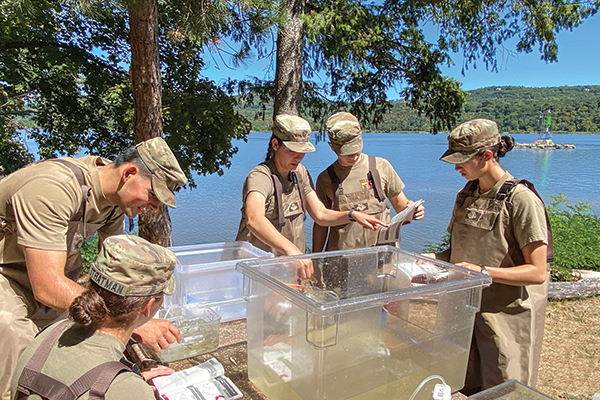By Erika Norton, WPAOG staff
The West Point garrison and reservation encompass over 16,000 acres of land, from military training ranges to historic trails, and includes access to several bodies of water, including the Hudson River. This diverse landscape allows instructors from all departments and disciplines to expand the limits of their classrooms and use the great outdoors to supplement cadet learning.
From the departments of Civil & Mechanical Engineering and Physics & Nuclear Engineering to the more obvious Department of Physical Education and maybe less obvious History Department, instructors from a wide range of classes use the outdoor spaces around Post. These outdoor advantages allow West Point cadets to become better leaders of character who achieve excellence not only physically and academically but as military leaders throughout their Army careers.
“Who doesn’t like to get out of the classroom to learn?” said Geography & Environmental Engineering (G&EnE) Department Head Colonel Mark Read ’92. “For each of the four disciplines we teach in G&EnE (Geography, GIS, Environmental Science, and Environmental Engineering), getting cadets outdoors into West Point’s ‘living laboratory’ helps them connect what they study in class and read in their texts to the real world—it helps them connect the dots on so many of the topics and subjects we study.”
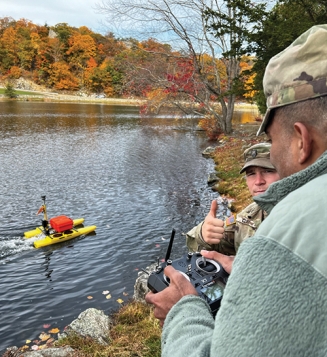
Bodies of Water
According to Read, since Lusk Reservoir serves as the water source for West Point’s primary water treatment plan, Environmental Engineering students and Civil & Mechanical Engineering (CME) students often study the reservoir, mainly for water quality.
Students in CE350: Infrastructure Engineering take a trip section to Lusk and study the water treatment process, from water collection in Lusk Reservoir to storage tank, according to CME instructor Major Brett Rocha ’12. CE350 also uses the Transportation Motor Pool (TMP) across from Camp Buckner for another trip section. The cadets do a reconnaissance of the TMP, examining the existing site layout to develop a site plan to use the TMP as an intermediate staging base for a battalion-sized element. Cadets then determine the changes that would need to be made to the infrastructure as well as estimates for the amount of excavation that would be needed to make the site suitable for its new purpose.
Cadets have also conducted independent study research in Lusk to measure microplastics, and recently cadets in EV380: Principles of Surveying used a “HyDrone” to apply hydrographic surveying methods to measure the depth of the reservoir, according to Read. Cadets collected 3D terrestrial laser scans for portions of the shore while the HyDrone R/C catamaran was used to measure echo soundings of depth throughout the reservoir.
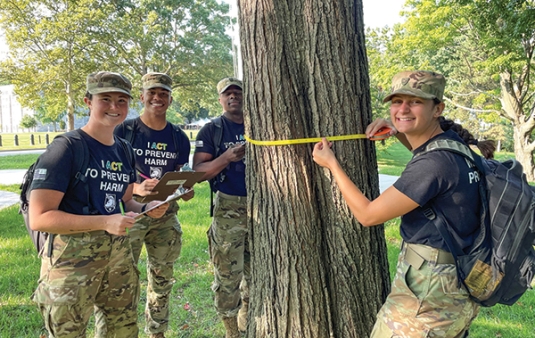
“Using these outdoor resources enhances cadet learning because it takes the concepts taught in the classroom and brings them to life,” Rocha said. “The cadets are able to see firsthand the complexities that exist in the real world and how engineers need to come up with creative solutions using the concepts taught in the classroom as a foundation.”
West Point instructors also take advantage of their proximity to the Hudson River, one of the most important estuaries on the East Coast. According to Read, Environmental Science majors in EV310: Aquatic Science spend a significant amount of time studying the river. Cadets collect and analyze water samples and aquatic organisms from throughout the Hudson River’s tidal period to understand how water chemistry and biodiversity varies over time. As high tides move the salt front upriver from the Atlantic Ocean, water chemistry can change significantly in comparison to low tides, during which the river experiences more impact from freshwater inputs originating at local watersheds.
Land Resources
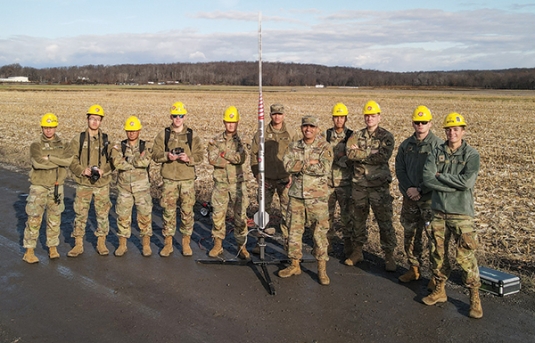
Cadets use the land around Post in a variety of ways for academic learning. Students in the elective course CE472: Advanced Soil Mechanics visit construction projects around West Point that are at the groundwork stage of construction. Recently, cadets visited the West Point Cemetery Renovation Project and analyzed the soils and geology that are common to West Point, making connections between the concepts taught in the classroom and what they look like in the real world.
According to Rocha, one of the Civil Engineering capstone teams designed and constructed a garden overlook at Kosciuszko’s Garden. “The project honors the heritage of the site as well as the Legacy of Lieutenant Colonel Tadeusz Kosciuszko,” said Rocha. “Cadets surveyed and marked the existing site, then mixed and placed concrete that will serve as the foundation for the overlook, all while taking into account for their design the existing site conditions and the creative solutions needed for building on the sloped rock face.”
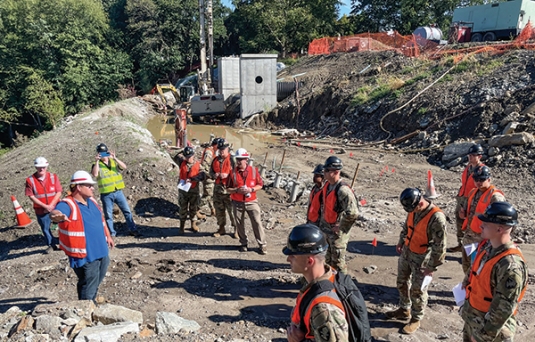
“The West Point landscape is heavenly for a geologist!” notes Read. Cadets in EV388A: Physical Geology practiced different geological field methods with rock hammers and pocket transits on the many geological formations in the local area.
Several classes also use the area around iconic Trophy Point. Geography students collect tree growth data at Trophy Point as part of a lab exercise in EV367: Geographic Research Methods. Last fall, cadets measured trunk diameters for six different tree species, calculated the approximate date each tree sprouted, and mapped tree locations in response to research questions they developed in the classroom. Cadets in EV300: Environmental Science also use Trophy Point, identifying terrestrial species in and around the area to model the biodiversity of West Point’s local ecosystem for the course’s biodiversity lab.
Camp Buckner and Surrounding Military Training Land
Unlike other colleges and universities, West Point has acres of military training land. However, this land is not just used for Department of Military Instruction courses or Cadet Summer Training; other academic classes are able to use this land for lessons and research.
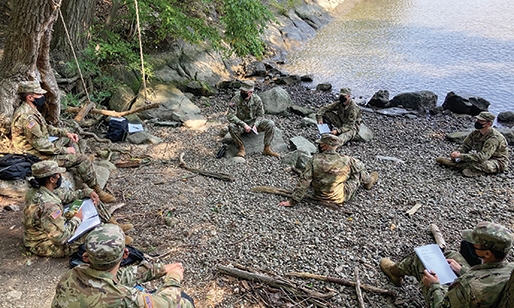
According to Colonel John Hartke ’88, Physics & Nuclear Engineering (PANE) Department Head, cadets enrolled in PANE courses have been launching and testing rockets at the training area ranges.
“Using the range complex provides us an opportunity that doesn’t exist at almost any other university,” Hartke said. “I don’t know anyone else who can go out in what is essentially their backyard and fire a kilowatt-class laser, ignite rocket motors, or spread out some nuclear material, making the experiential component of the academic program in our department significantly better than it could be without the range complexes and the cooperation of the range staff.” Due to the height and distance their rockets are starting to achieve, they’ve had to start going off-post to spacious farm fields.
“Using these outdoor resources enhances cadet learning because it takes the concepts taught in the classroom and brings them to life,” Rocha said. “The cadets are able to see firsthand the complexities that exist in the real world and how engineers need to come up with creative solutions using the concepts taught in the classroom as a foundation.”
— MAJ Brett Rocha ’12, CME instructor
Another one of PANE’s research efforts is the Outdoor-High Energy Laser Lab (O-HELL). Cadets transport a high-energy laser in a car trailer and take several trailers of scientific equipment out to Range 5: Gettysburg and conduct research on how the atmosphere distorts a laser beam. According to Hartke, this research supports the Army with developing and preparing to transition a laser weapon as a program of record.
Nuclear Engineering majors also take advantage of the outdoors. Every year, cadets conduct a nuclear-detection exercise out at the MOUT (Military Operations in Urban Terrain) site. Faculty and staff distribute radioactive sources throughout the training area, and cadets are placed in tactical scenarios for which they must detect, characterize and determine the military relevance of the nuclear materials. Hartke said that they get support from the 2nd Aviation Regiment to do air-mounted detection. They have also used robot detectors in cooperation with the Department of Electrical Engineering & Computer Science.
Outdoor Athletic Facilities
A department obviously conducive to outdoor learning and training is the Department of Physical Education (DPE).
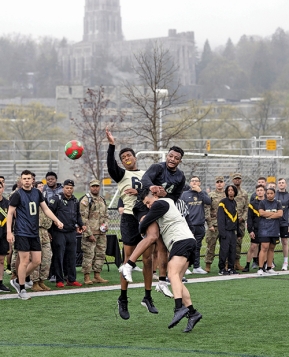
“Given DPE’s primary role as steward of the Physical Pillar at USMA, all outdoor spaces are potential classrooms,” said Colonel Nicholas Gist ’94, DPE Director. “In educating, training, and inspiring cadets to develop as leaders of character, and in our physically demanding profession, athletic fields, obstacle courses, lakes/rivers/ponds, and nearly every other outdoor space provide an opportunity to develop physical attributes individually and collectively as part of teams.”
Specifically, PE215: Foundations of Personal Fitness and PE450: Army Fitness Fundamentals use a variety of outdoor classrooms to conduct physical fitness assessments or to perform Physical Readiness Training labs led by cadets, according to Gist. Within the Lifetime Physical Activity courses, outdoor lessons include road cycling and mountain biking, golf, tennis, aerobic fitness, skiing, snowboarding, and soccer.
“Outdoor classrooms require instructors to identify, mitigate, and manage risks that include temperature, humidity, precipitation, and a variety of synthetic and natural surfaces,” Gist said. “While gymnasiums have a variety of venues and equipment types, the outdoor environment requires leaders to innovatively use implements and terrain immediately available while performing composite risk management to achieve planned outcomes for Physical Readiness Training, athletics practice, and even formal competition.”
Historic Sites
Another advantage unique to West Point is the many historic sites all over post, which can be used to teach cadets the rich history that led to the creation of the nation, as well as the founding of the Academy itself.
“The outdoors is used by students and faculty frequently,” said History instructor Major Thomas M. McShea ’10. On any given day, particularly during nice weather, there are likely one or more History classes being held outside. “Other instructors and I have brought cadets to the parade field bleachers, the fortifications on Flirtation Walk, and to Battle Monument and Trophy Point,” said McShea. “We do this because the chosen site is tied to the lesson in some way; we’ve even done reenactments with cadets and reenactors near the Plain and around the River Courts.”
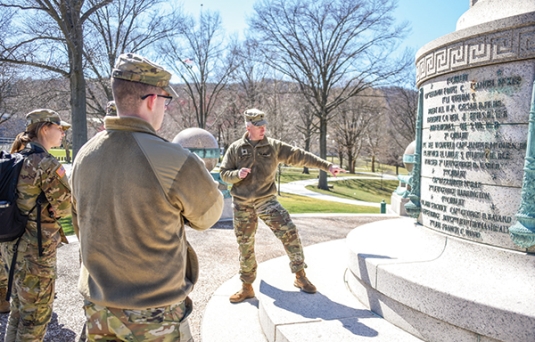
A long-term project that’s using these historic sites is the Mapping the American Revolution in the Hudson Valley Project that McShea initiated last summer. Part of the project’s purpose is to allow educators, teachers, and researchers to experience West Point’s historic sites and landscape even if they cannot travel to West Point to see it themselves. McShea and a cadet from the Class of 2023 collected footage, photographs, and old maps of West Point, Bear Mountain, Stony Point, and other sites to build online story maps that combine geospatial depictions of the Hudson Valley in the 1700s with modern imagery and historical narratives.
“The idea is to help make our rich history and sites more publicly accessible,” McShea said. “We went all over the Hudson Highlands for this project and are developing a product focused on the West Point fortifications themselves.” The project is scheduled to debut in the near future, with a new team employing the Department of History’s drone to create a digital staff ride of the Battle of Brooklyn Heights.
The team has published one story map so far focused on the Battle of Stony Point, which involved 12-mile hikes and multiple days spent at Stony Point to collect pictures and video footage.
“Much of the history we teach cadets is written into our Academy grounds, and History instructors, as well as instructors in other departments, take advantage of that, especially when teaching about the American Revolution, Civil War, and other topics memorialized outsdoors here at West Point,” said McShea. “It is a truly inspiring place to be for cadets and faculty alike.”
Read the complete Summer 2023 edition of West Point magazine here.

